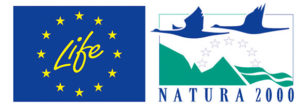The LIFE Wetlands4Climate project works to demonstrate that properly conserved wetlands are a powerful ally in the fight against climate change.
Our programme of actions is wide-ranging.

in 10 pilot Mediterranean wetlands selected to trial management measures and analyse their potential to mitigate climate change.

Design of an experimental protocol to assess the sink potential of the pilot wetlands, taking into account their state of conservation, and to plan vegetation, soil and water management measures. At each wetland, measurements are taken to assess the effects of these measures on primary production and respiration involving the main gaseous forms of carbon (i.e. CO2 and CH4). These will be used to estimate the balances of carbon-based GHG emissions/capture and the role of the microbial community primarily responsible for the biogeochemical processes taking place in wetlands.
to evaluate the wetlands’ capacity as carbon sinks or carbon sources and the influence of various environmental factors on this capacity. The protocol will also set out recommendations for vegetation, soil and water management.

Creation of various management measures tailored to the ecological characteristics and state of conservation of wetlands with the aim of maximising carbon capture/storage capacity.
to mitigate the carbon footprint of private sector entities through a range of wetland management and conservation measures, incentivising investment in conserving these ecosystems.
that will cover both coastal and inland wetlands and have a climate perspective. Development of training materials to familiarise wetland managers with the most appropriate management techniques.
Selection of sites
Ten pilot wetlands have been selected for the study at locations in Castile-La Mancha, Castile-León and the Community of Valencia. The wetlands fall under various types characteristic to the Mediterranean biogeographical region where they are found, including coastal wetlands, inland freshwater wetlands, and inland saline wetlands. During the initial phase, the plan is to characterise the physical, chemical, hydromorphological and biological conditions in the wetlands.
Characterisation and measurement of carbon flows in wetlands
Design of an experimental protocol to assess the sink potential of the pilot wetlands, taking into account their state of conservation or restoration, and to plan vegetation, soil and water management measures
Based on the experience and knowledge generated by previous UVEG studies, the project will work to design a sampling and experiment plan to measure primary production and respiration involving the various forms of carbon (i.e. CO2 and CH4) in each of the wetlands selected for the project to estimate the effects of management actions on carbon emission/capture balances. The effects of the different management measures on the microbial community primarily responsible for the biogeochemical processes taking place in wetlands will be studied in detail. The overall aim is to design guides to managing the different types of wetlands from a climate change mitigation perspective.
Protocol for evaluating wetland quality
Design of a practical protocol to evaluate wetlands’ capacity as carbon sinks or sources and the influence of various environmental factors on this capacity. The protocol will also set out vegetation, water and soil management recommendations.
Management of pilot wetlands through vegetation, soil and water management
Different management measures tailored to the ecological characteristics and state of conservation of the selected wetlands will be applied to each with the aim of maximising carbon capture/sequestration capacity and in particular to reduce emissions of the carbon-based gases that contribute most to global warming, such as methane.
Monitoring of the entire process
The results and effects of each of the management actions applied to vegetation, soil and/or water will be analysed using various monitoring indicators. Apart from monitoring biological indicators and indicators of the ecological state of the pilot wetlands, other indicators on the socioeconomic impact of the actions implemented will also be analysed and the carbon footprint of the project actions calculated.
Information accessible to all

informative videos, social media campaigns and educational activities targeting the general public.
updates on the progress and results achieved during implementation of the project in specialised journals and media.
guides to coastal and inland wetlands management establishing the methods to use to expand their function as carbon sinks, along with a database of results with rates of carbon cycle processes and other management indicators. This will include the publication of scientific articles.
Protocol for the verification and certification of carbon credits
The data obtained will be used to agree a methodology that may encompass opting into funds on the voluntary carbon market based on the conservation and efficient management of Mediterranean wetlands, accelerating the synergies between society and the economic sphere to boost the transition to a decarbonised economy.

Creation of knowledge networks
Contact with other entities managing projects similar to LIFE Wetlands4Climate and initiatives related to wetlands conservation and management and climate change.
Creation of materials to familiarise wetlands managers with the most appropriate management techniques to maximise wetlands’ carbon sequestration capacity.
Creation of a committee to monitor the project and coordinate with institutions, experts and stakeholders participating in wetlands management and holding climate change mitigation powers.
El proyecto “Gestión y restauración de humedales mediterráneos como sumideros de carbono – LIFE Wetlands4Climate (LIFE19 CCM/ES/001235) está cofinanciado por el Programa LIFE de la Unión Europea

Las opiniones y documentación aportadas en esta publicación son de exclusiva responsabilidad del autor o autores de los mismos, y no reflejan necesariamente los puntos de vista de la Comisión Europea.
Política de Privacidad
Política de Privacidad en Redes Sociales
Política de cookies

Nos dedicamos a la conservación de la naturaleza
C/ Tajo, 2, 28231 Las Rozas (Madrid)